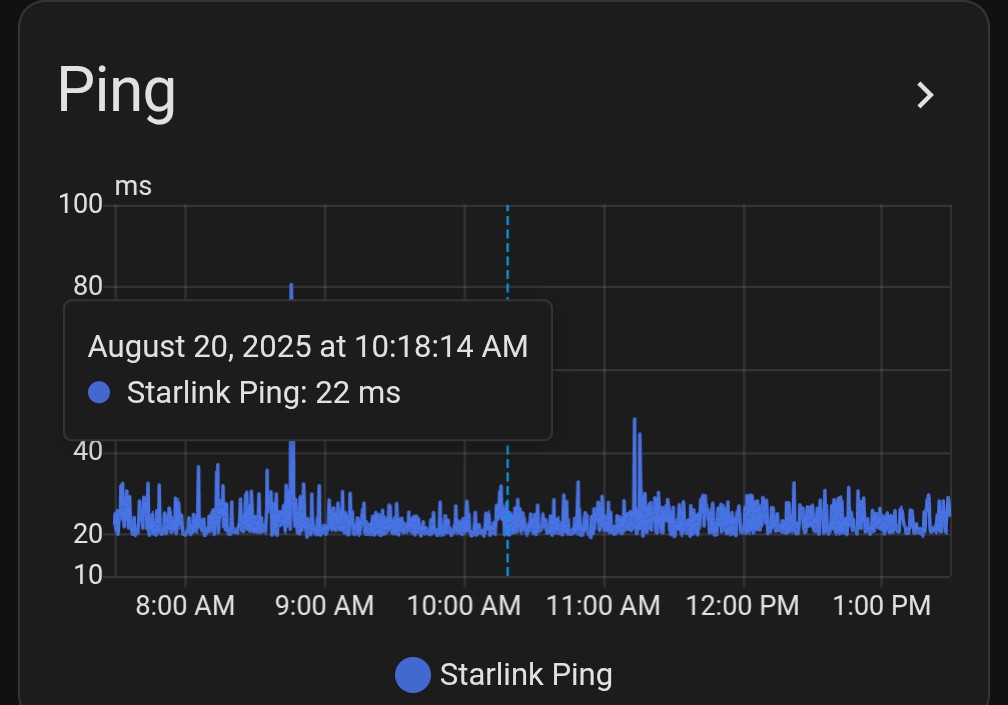all you can eat latency and an oversaturated network on devices with a limited lifespan… what else could you ask for!
Starlink has much better latency than most satellites, but still 10 to 50 times as much as fiber.
ha yeah… not having to make a 340 mile round trip instead of the hundreds of feet to the nearest router will do that
Uh, how often are you using the Internet to connect to a computer in your home town? Maybe 5% of the time?
I’ve never used Starlink, but with a basic understanding of geography and optics, I’m going to bet that in most scenarios the latency difference between Starlink and fiber is negligible, sometimes even being faster on Starlink, depending on the situation.
That said, I’m not suggesting Starlink is a realistic replacement for fiber, just that latency isn’t the big issue. (It has other serious issues)
Much more frequently than you think with CDN endpoints.
Ok, so actual question, How useful are CDN endpoints these days with https everywhere? Because most encrypted content is unique to a single web user, caching isn’t super useful. Also you can’t cache live content like video calls or online games. I’d imagine the percentage of cacheable content is actually fairly low these days. But like I said, I don’t actually know the answer to this, i’d be curious to hear your take.
Edit: it’s weird to get down votes for a question.
HTTPS can in fact be cached, and most modern browsers will do so unless given a header or something to tell it not to.
Source: Devtools network tab + https://developer.mozilla.org/en-US/docs/Web/HTTP/Guides/Caching
Browsers partition the cache by “origin” now though, so while it can cache HTTPS content, it can’t effectively cache shared content (It’ll store multiple independent copies).
So Youtube still works fine, but Google Fonts is pointless now.
Edit: Oh yeah, and any form of shared JavaScript/CSS/etc. CDN is now also useless and should be avoided, but that’s always been the case.
HTTPS / TLS has little to do with it. Don’t think of the endpoint as a cache between you and the origin. The DNS name given to the endpoint is the origin from your browser’s perspective. How content gets cached on the backend is irrelevant to the browser. Live video that someone else in your area is also watching is cacheable. Images to load a page, very cacheable. The personal stuff is mostly HTML specific to you but that’s quite small.
Netflix and Amazon Outpost makes it quite useful.
I live near DE-CIX and have fiber. So a decent chunk of web services I use is available with a latency of under 5ms. And everything else hosted in a European datacenter with under 20ms.
So almost all of my internet traffic has a lower latency than starlink has under ideal conditions
Living right near a massive CX that services the US-Canada border… most times.
Just for reference, I get about 45-50 ping playing Marvel Rivals on Starlink.
On fiber, while I don’t play that game, I’ve never seen a ping longer than 10-13msecs.
The point is, unless you’re playing some hyper competitive game where a 30ms difference in reaction time is noticeable (this is less than 1 frame in a fighting game, for example) Starlink works perfectly well. Lower numbers are better, but for games you only need to compare that number to human reaction times (150-200ms) to see that both are small values less than the reaction time of any person.
Previous satellite Internet using satellites in geosynchronous orbit had 1500ms latency, for comparison.
where a 30ms difference in reaction time is noticeable (this is less than 1 frame in a fighting game, for example)
You have some pretty bad understanding of how netcode works if you think a 30ms ping in an online multi-player game means your game or input is delayed by 30ms. It’s a lot more complicated than that, and especially in games with bad netcode you will absolutely notice a difference between 10ms or 30ms ping
Oh, please explain the complexity to me like I’m a system administrator with only 25 years of experience. I didn’t realize that computers could connect to each other over a network until 3 days ago, imagine my surprise.
You could start with the fact that many online game servers (ex: Valorant, Apex, Overwatch) artificially increase everyone’s latency at the server, except for the people with higher network latency in order to compensate for lag through a technique called lag compensation. So having 10 ms ping and 50 ms ping just means the server introduces a 40ms delay on the player with 10ms ping so both players experience the same latency.
Or maybe you could explain how game state updates happen with a set frequency and the gap between the state updates can also be adjusted by the server for each client so that state updates are sent to higher latency users earlier in the update window. I mean this technique is essentially lag compensation as well, but it applies to how the client updates are sent instead of being applied to incoming packets.
Or, you could avoid all this and simply declare me incorrect by pointing at a game that doesn’t use lag compensation or otherwise move the goal posts so that you don’t actually have to explain the complexity that you were hinting at.
Previous satellite Internet using satellites in geosynchronous orbit had 1500ms latency, for comparison.
Yes, and are far more stable, not hyped, and are already at pretty much peak congestion. Starlink will get progressively worse, the more people use it. Right now, it’s over provisioned.
The point is, unless you’re playing some hyper competitive game where a 30ms difference in reaction time is noticeable (
Ever try a voice call with 30ms of latency?
Ever try a voice call with 30ms of latency?
Lol what? You’re not gonna notice a 30ms delay in a voice call…
@ubergeek@lemmy.today downvote with no reply even though you were painfully wrong. Sad.
Yeh, 30ms is still inside the haas delay.
If you are a professional listener (sound engineer, musician, dancer) then you can probably perceive it (in a similar way that eyes theoretically only need 25fps, but 60/120/144 is noticeably better).In 30ms, sound can travel 10 meters.
So, if you’ve ever had a conversation with someone across a classroom, you’ve had a conversation with 30ms latency.For data, 30ms is 8100 km for electricity over copper, or 6000km for light over fibre.
Meaning 30ms over fibre (considering no transmission delays) would be roughly the direct distance between US and UK.
So yeh, 30ms is nothing
And I’ll downvote ya again, if I could :)
FWIW, I don’t owe you a reply :)
Yes, and are far more stable, not hyped, and are already at pretty much peak congestion. Starlink will get progressively worse, the more people use it. Right now, it’s over provisioned.
They were not more stable. Any occlusion, including thick clouds, would degrade the signal to being unusable. I used Hughsnet for years, then swapped to cellular (100ms+ latency) and finally to Starlink. Starlink is a pretty solid 100Mb/s, with low jitter, packet loss and latency.
Ever try a voice call with 30ms of latency?
Yeah, I use voice chat every day, it’s not noticeable.
They were not more stable. Any occlusion, including thick clouds, would degrade the signal to being unusable
You have the same issue with Starlink…
Yeah, I use voice chat every day, it’s not noticeable.
The people on the call do…
That’s basically perfect, with regards to online gaming.
I got better ping playing Quake multiplayer in 1996
Online and not LAN? I have doubts.
That used dedicated servers, right?
So if my ping is currently 90ms on fiber, it’ll become 900ms - 4.5s on starlink?
Probably no. Your ping is abnormally high for fiber, I’d expect a sub 10ms ping for you.
That makes a lot of assumptions about what I am pinging, and the networking context.
In my case I was quoting my average ping in VRChat.
How can you quote 10-50 times higher and then tell me no when I calculate what that means for me?
Is it because latency does not scale in that way?
Is it because latency does not scale in that way?
Yes, your understanding is fundamentally flawed. Starlink adds a fixed latency on top, if you ping to a server was 2ms with fiber and 52ms with starlink, then your ping to a server that would be 100ms with fiber would be 150ms with starlink
Of course. Still, an exception doesn’t disprove expected averages.
So you were only talking about when testing with ideal servers? Why is my example an exception? Are all games an exception?
Because we’re talking about the inherent latency of the connection, obviously.
- Run a
tracerouteliketraceroute cnn com - Kill that by
ctrl-cat the third line. - Ping that third IP address.
Don’t try to ping UK.battle.net or your numbers will be skewed by everything in between.
About 5ms.
Based on the various replies, it sounds like the poster I was originally replying to does not mean pings in any context.
They just mean in this context. Along optimal routes. Right?
Of course they don’t mean in every case. Yeah, if you have to go halfway around the world from two addresses that are very far away from hubs, Starlink might be better. 99.99999% of the time this isn’t happening though and fiber will be better. There are situations for some people where it’s worth it. Fiber is better for the average case though, and it’s where money should be invested.
So then 10x makes 50ms; sounds about right
- Run a
You’re probably really far away from the VR Chat server. Try pinging Google or Cloudflare, which will tell you ping to the nearest datacenter (a rough estimate of ping caused by your local ISP).
Based on their numbers, you could probably expect 50-100ms to Google, and then add an extra 90ms to get from there to your VR Chat server.
My personal fiber connection gets under 2ms ping on Speedtest
It depends on the instance (people can make them in 4 regions of the world) but 90ms is common for US west and east, for me.
- Cloudflare.com: 5ms
- Google.com: 24ms
That makes sense then. When people talk about their ISP ping, they’re usually talking about how long it takes to get out of the ISP’s network. So that 5ms Cloudflare ping is likely pretty close to what people would consider your internet’s ping.
Speedtest.net is a really common tool for measuring this, since it will automatically check where the closest server is. For your connection, any ping above 5ms you can probably assume is based on your physical distance to the server, or latency on the server’s end. I’m guessing Google doesn’t have a server quite as close to you as Cloudflare
My average latency on Starlink over the past year is 32 ms. It varies throughout the day from around 20 to 40 ms.
If you are getting 90ms on fiber, you are either pinging a server that’s a long ways away or something is very wrong.
If you look at the rest of the comments, you’ll see I was taking about my ping in a game. Not my shortest path to a nearby server.
A subscription that somehow still manages to use surge pricing? I’m assuming that’s the next logical step.
Well, to be fair, the dishes do make great outdoor cat beds!
I’m a starlink customer and think it’s one of the best advancements in the past decade as it provides real access to rural addresses. The side effects of this is nearly immeasurable.
Spacex needs to STFU about this though. Fiber should continue to be deployed where possible.
Fiber should be deployed to rural addresses like yours (and should’ve been a long time ago). Instead, that money was funneled to the likes of Time Warner and Comcast who never even followed through on their part of the deal. Now, SpaceX is getting funneled the cash.
I’m super thankful that WA State supports and gives assistance to counties building out public LUDs for fiber access, many paying attention to rural communities first. I escaped Comcast two years ago because of it.
Time Warner and Comcast need to have all that grant money clawed back. They contracted with the taxpayers to deliver a service and they didn’t even make a good faith effort to start.
Hello neighbor!
Fiber should be deployed to rural addresses like yours
I don’t disagree, it should be deployed to rural areas. It’s never going to happen though, it’s just not profitable.
Sure, electrical infrastructure was deployed to the whole country, but it doesn’t need to be replaced and upgraded as frequently as Internet infrastructure does. Even if some rural areas do get fiber at some point, don’t expect the infrastructure to be upgraded regularly enough to stay comparable to denser areas.
You’re never going to find a company willing to do that job. We could do it at the national level, but I have my doubts that the country is headed in that direction.
That’s what the subsidies are for. Plus, fiber does not necessarily need to be upgraded after installation (especially rural, where there’s less customers in general). It’s not copper or coax, it doesn’t have the same limits, and can usually handle huge amounts of data (the limit primarily being the transceivers at both ends). The costs of upgrading would also likely be lower than the initial install, something that couldn’t be said about providers like Starlink. Fiber is about the most efficient, cost effective (especially in the long term), and future proof way to provide internet. Starlink is overall much more expensive to maintain.
But yes, without the local, state, and/or federal governments supporting it, people in rural areas won’t have a choice.
That’s what the subsidies are for.
Yeah I’m not in favor of that, not again. The US has provided funding to ISPs to be used explicitly in expanding rural broadband access, we’ve done it on multiple occasions. Every time ISPs simply pocket the money and do nothing.
Fool me once, twice, three times…
So hey, if the US wants to have the FCC do it themselves, just hire crews to lay fiber, then sure. It’ll be inefficient and expensive, but it would at least get done. But I’m not in favor of giving a dime to the existing ISPs…
You miss my point. My original comment says as much, that the subsidies all went to big telecom, but it should have gone to local utility districts for local buildouts of fiber. I’m literally sending this message from my LUD-funded fiber that my state subsidized, and my ISP is a local company exclusive to my county’s fiber network. It’s fantastic, and what should be getting the funding instead of Comcast, Time Warner, and now SpaceX.
Most of the addresses my LUD serves are unincorporated, including mine. So, it actually is possible, if your state and county give enough of a shit.
Well you’re absolutely right then, sorry for the confusion.
Nationalized fiber networks or locally managed municipal fiber has always been a winning proposition. I’ve heard so many success stories about those rollouts and the only opposition to them has come from big ISPs who are scared they’ll be replaced (because they should be). Unfortunately, that’s a really strong opposition… Those ISPs have so much money and so much power, they’re managing to shift legislation, pass laws that make municipal fiber systems illegal (for the benefit of the consumers of course).
It can’t, and the taxes you would pay to support fiber to my home would be extreme.
But fiber to a local wireless solution? Sure. But even that’s not possible for everyone, and they were expensive and unreliable until starlink started showing up. LEO internet has its benefits.
Except that US ISPs have already been provided upwards of $80b to roll out a fiber optic backbone for rural connections, and have instead largely pocketed the funds and sat on their hands.
It has largely fallen to smaller communities to incorporate their own local ISPs and manage their own roll-outs, as such projects aren’t viewed as worthwhile for private companies.
Honestly, if Australia could roll out a national fiber backbone (almost a decade ago!) across the same approximate landmass as the contiguous 48 states at less than 10% of the overall population; there is no valid reason that the wealthiest nation to have ever existed can’t also do so.
Even if a Federal program (not under this administration, obviously) was to just run fibre parallel to the existing interstate highways, and leave the last (20) miles to local utilities - it would be cheaper, faster and more reliable than LEO - and without all the additional negatives that come with that!
Honestly, if Australia could roll out a national fiber backbone (almost a decade ago!) across the same approximate landmass as the contiguous 48 states at less than 10% of the overall population; there is no valid reason that the wealthiest nation to have ever existed can’t also do so.
Did Australia lay a national backbone as you said, or did they connect individual neighborhoods, or individual homes? Because all three of those are very different situations with very different costs associated.
I mean the US has had a national fiber backbone since 1995, but that doesn’t really mean anything about fiber to the home. I’m not sure rolling out a fiber backbone 10 years ago is really anything to brag about. However, extending the backbone to connect neighborhoods would be extremely helpful in lowering the costs to get fiber to the home, if that’s what they did in Australia, then that would indeed be laudable. If at the national level, they payed for fiber rollout to every home or every street… Well that would surprise me, but that would also be awesome!
So yeah, what did they do?
Edited to add: sorry, backbone was probably the wrong term to use.
The actual history of Australia’s National Broadband Network (NBN) is actually needlessly complicated - primarily due to a (somewhat) successful sabotage attempt by our Conservative government in the early 2010s.
But basically, every single new home is built with Fiber to the Home, and every single metropolitan and suburban home either has Fiber to the Home (or Premises), or at the very least Fiber to the Curb through a remediation process to replace the Conservative-implemented Fiber to the Node boondoggle.
We also have a number of neighbourhoods stuck with HFC (again due to Conservstice sabotage) which while still delivering 100+ Mbit connections - are a bit of a technical dead end and will need to be remediated at some point in the future.
Basically, nbnCo serves as a national broadband wholesaler providing high speed connectivity (100, 250, 500, Gigabit) to something like >95% of the population.
The most remote communities are also serviced either through a fixed wireless option or satellite.
Basically though, unlike the US we don’t have a significant number of people still on dial-up and haven’t had so for a very long time.
I’m sure we could afford it from muskrat’s government contracts ( our tax money )
We can definitely afford it, especially with LUDs plus federal subsidies. That’s literally what they’re for.
Fiber also has far better performance that satellite can never match.
there’s no fundamental physics limitation that makes this true. in fact, light in a vacuum travels faster than in glass fiber, so the theoretical latency of LEO internet is actually faster compared to fiber over a certain distance
For nieve signal distances, that can sometimes be true. That’s not how starlink works however. It bounces the signal between satellites, each adding latency. Overall, fibre wins in almost every situation.
The bigger problem is saturation. Most things you can apply to radio waves can be applied to light in a fibre. The difference is you can have multiple fibres on the same run. This massively increases bandwidth, and so prevents congestion.
Just checked the numbers. Starlink is up at 550km. That means a minimum round trip of 1100km. In order to beat a fibre run, you are looking at over 2000km distance. Even halving that to (optimistically) account for angles, that’s still a LONG run to an initial data center.
This makes no sense on the face of it. Let’s say the satellites are 100 km (or miles) above the earth. If I was to connect to a server 10 km (or miles) away, my complete route over fiber is 10 km. My complete route over satellite is just over 200 km (assuming it’s between those two points). Now, let’s say the server is 500 km (we’ll assume the earth is flat over this expanse, even though that’s about 5° around the earth). So our fiber link has to go 500 km, more or less. Our satellite link has to go about 540 km, best case scenario. If we raise those satellites, it only gets worse (it’s probably closer to 860, best case scenario, for satellites at 350 km).
I just did a quick check, and the curvature of the earth over that 500 km scenario is about 20 km (it won’t be 20 miles for 500 miles).
Now, you might start to argue that were talking about straight lines, and that’s true for satellites but not for fiber. And that might be true. But we’ve already shown that the hop to space and back is already increasing that distance by 60% or more. But those two or so straight lines are just til you get to the Starlink hub, so you aren’t going to reduce this much more than the numbers above. And yes, fiber will have some extra distance due to following the grid rather than straight lines. But, again, that only matters to the ISP hub and then you’re back to the same distances.
The other argument you listed is the speed of light in space/atmosphere vs. fiber, and it’s a valid point. Not there are some interesting things done with guiding light to the center of the fiber, which is another way of saying there are multiple refractive indexes, but let’s go with a refractive index of 1.5. That means the speed of light in glass is 2/3×c, or that light in space can go about 50% farther. And that’s about the added distance for using LEO satellites.
tldr: All the benefits of transmitting through air or space are basically negated by the added distance, where the best-case scenario is only slightly better than the worst-case scenario for fiber.
Satellites need to orbit at some distance above the planet though, so the round trip will always be fairly long even for ones with a pretty close orbit.
Seriously, this is in the “well, we know you want all the free money you can get, but: no. Now go do your thing on your own dime.”
Fiber in the ground is infrastructure like paved roads. Satellites? One counter-orbiting frag bomb can take out a satellite constellation in less than a day.
The side effects include filling orbit with space junk, crashing satellites to Earth, and blinding our ability to see meteors with a collision course for Earth. The side effects may not be predictable, but they’re definitely measurable.
Starlink has been much better than every other option where I am, but I will switch to fiber as soon as it gets here.
They’ve been promising fiber here for over a decade, but I can finally see them installing it two miles up the road now. Hopefully it will actually be available sometime soon.
What’s wrong with 4g? I live in a rural region and have been using it for years
Unreliable, high latency, slow bandwidth and data caps?
None of the issues you mentioned are 4G issues in itself. Do you realize the sarellite is much further away than 4g tower? It sounds like bad ISP. I have none of said issues. Even gaming is great, getting around 20-30ping on local country servers.
I’m not defending satellites, I’m saying fiber is much superior at all the things I mentioned above.
For me? 40/5 was about the best I could get. Mountains between me and the towers.
Hmmm ditch lightning fast and stable fiber for the mediocre speed and unstable micro satellite internet connection controlled by a petty asshole…
What to do, what to do?
Just think how much control he can have if he owns the medium which people access the internet.
And he’d only do good things with that power /s
I mean, you don’t have to guess. He’s interfered in a war and turned a social network into his personal bullhorn.
“Give me all your money” says world’s richest person, in a fit of originality.
Basic physics says satellites using Ku-band or whatever they use can’t compete with fibre.
Satellite internet has its uses like for ships at sea.
Or rural and remote areas. I think it would be a ton of fun to go backpacking with a foldable solar panel and an antenna.
4G towers can have 100km radius
Maybe on flat ground under ideal circumstances, but there are plenty of times I go camping just a few km off the main road and the cell signal is completely gone.
Fibre is an investment that can be used and upgraded for decades. Starlink is a subscription service forever to a private company.
And upgrading is piss cheap. Just change transceivers.
Same fiber cable that does 1gbps can do 100tbps.
That’s not true… There are different types of fiber with different throughputs depending on the class of the cable and the length of the installation.
It is true.
Multimode (what I think you’re trying to reference) isn’t used in distance applications at all, it’s only for short in-building links. Anything that your ISP would provide you would be single-mode. Carrier/Backbone is virtually 100% SMF as well. SMF (OS1 and OS2) don’t really have a bandwidth cap. It’s all transceivers not the fiber.
But the point is that fiber that ALREADY in the ground, you can upgrade simply by changing the transceivers. It doesn’t matter the length, SMF/MMF, or anything else… you just get a transceiver rated for the length of run (power of the led/laser, and the optics). The length is irrelevant otherwise as the presumption is that the install in the ground has been shown to work in the past already.
Old standard ITU-G.652 single-mode has been made to push multi-petabit transfers in lab environments. The only change was the transceivers. And to be clear, ITU-G.652 was standardized in 1984. Nobody rips out the fiber from the ground (caveat is that the cable itself hasn’t degraded). You just upgrade the optics/transceivers.
“It’s not the fiber that’s limiting—ITU-T G.652 defines physical specs (dispersion, attenuation), not throughput. Field trials over 96.5 km of real-world G.652 fiber showed 56.5 Tb/s using advanced DWDM and modulation
source: https://arxiv.org/abs/2108.01873
Your statement didn’t specify an application!
The context of the discussion does…
SpaceX doesn’t provide in rack or in-building connectivity.
SpaceX is an ISP. You wouldn’t have an ISP running multimode.
ISP’s absolutely run multimode. That’s how you get fiber into a building or between buildings. Different types of fiber all play a role in a network deployment.
Broad statements are misleading. OM4 multimode won’t push 10gb at 500meters no matter how good your hardware is.
Broad statements are misleading.
Ignoring the context of the discussion is even more misleading. In the context of this conversation, ISPs providing consumer connections and obtaining grant money, my statement is 100% accurate.
That’s how you get fiber into a building or between buildings.
You just said multimode can’t do significant speeds at distance, yet claim that buildings separated by distance would be connected with it? That logic doesn’t hold.
Intrabuilding or intrarack Yes, you’ll find multimode fiber occasionally. But even these rare cases are increasingly replaced by single-mode as costs drop and bandwidth needs rise.
Everything else (ISP deployments, backbones, FTTH) Single-mode fiber dominates. I haven’t seen a single ISP deploy multimode for consumer-facing services over a typical network radius (~hundreds of meters to kilometers). The only minor exception is MMF from the building network room to an apartment unit, which is irrelevant for this discussion and would be EXCEEDINGLY rare as most buildings would just copper line to the unit. But even in that case… the 20+km from the head end to the building counts for much more than the 20meters to the unit itself.
For all practical ISP purposes, single-mode fiber is what’s in the ground/on the pole, and upgrades are handled via transceivers, not ripping out the cable.
OM4 multimode won’t push 10gb at 500meters no matter how good your hardware is.
But just because you said it…
https://www.corning.com/catalog/coc/documents/application-engineering-notes/AEN075.pdf
and OM4 is suitable for distances up to 550 m
https://www.fs.com/uk/blog/om4-multimode-fiber-faq-highspeed-connectivity-guide-9499.html
OM4: Supports 10 Gbps up to 550 meters.
https://www.timbercon.com/resources/calculators/om1-om2-om3-and-om4-fiber/
OM4 Not specified 500 m* 150 m 150 m
*The IEEE has yet to officially give a distance for 10GBASE-S on OM4 fiber. The distances are decided by the IEEE in 802.3, not The TIA or ISO/IEC cabling standards. Some glass vendors say 500 m, but most are now quoting “up to 550m.”You absolutely can run OM4 at 10gbps at or over 500m depending on your optics/laser.
But Multimode was never the point of discussion as the whole thread is based around broadband services (virtually none of it serviced by multimode, if any at all) and grant money for rural area coverage. Any fiber upgrade in this scenario will 100% be SMF with no qualifiers. In my past 30 years of IT career all buried and pole mounted fiber is SMF that I’ve ever seen for an ISP. I can tell you for certainty that ever fiber I’ve buried in the past 10 years for several companies has been SMF. I’m not even sure that I’ve touched MMF in the past 5 years even in intra-rack setups, I think I might have gotten some with a government auction win about 8 years ago I wanna say? With costs of SMF at near parity for the cable itself and getting closer every year in the modules… it’s a dying form factor and was never really in use for ISP services to begin with.
My fiber ISP runs single mode to my home. And it means it’s all single mode on the pole for the neighborhood.
Multimode just isn’t used all that much anymore. We replaced all fiber links in our DCs with single mode recently. It’s just cheaper, and as the other person said: Its far more future proof.
Technically that’s true.
You just need to lay the 100Tb/s capable cable in the first place.
Except StarLink cannot possibly provide the same bandwidth, latency, and throughput a fiber connection can. Because of physics.
I can either share my 10G symmetrical connection with nobody, or with 200 others.
And, Fiber costs me $70 a month. Starlink, with worse performance, costs 4x more.
It’s not secure either. The next world war will involve efforts to sabotage satellites.
That’s the point. Musk wants control over the entire internet.
If all the other internet infrastructure was abandoned, he would be the most powerful person in history. Want to regulate him afterwards? He could just shut down the internet in your region until you accept his terms.
He has already meddled in the Ukraine war doing things like this, too. He turned off Starlink during an offensive Ukrainian mission. He claims he had to because civilian systems aren’t allowed to be used for a foreign incursion into Russia and that he’d face consequences. Which is a complete lie.
Musk wants control over the entire internet.
This is the number one reason my friend and I refused to even consider StarLink. We don’t live in the US and do not want all our traffic going through there.
Because of physics.
Pfff, physics, pesky detail! Clearly you are not a true visionary like Musk! /s
Starlink has no answer to dark fiber.
In principle I agree with you, but as a network guy, somewhere, between you and the server you are connected to, the bandwidth is shared. The only question is just where and how much bandwidth (well network throughput) there is to share. I work for a large university and our main datacenter has 10GbE and 25/100GbE connections between all the local machines. But we only have about a 3-5gb connection out to the rest of the world.
Now don’t get me wrong, I’d 100% rather have a symmetrical fiber connection to the ISP than something shared like radio or DOCSIS. I used to live in a neighborhood where everyone had Spectrum and about 5-6 PM the speed would plummet because cable internet is essentially just fancy thinnet all over again. Yes I’m old since I used to set up thinnet :)
PS: I would kill for $70 fiber where I am now. Used to have it but we moved to the sticks and I miss it terribly.
somewhere, between you and the server you are connected to, the bandwidth is shared.
But the difference here is that on a fibre connection the shared portion goes over higher speed trunks which gives you most of that 1Gbps bandwidth. A wireless connection has a limited number of slices in the same band that it can share.
It’s the same issue with too many people on a single WiFi connection.
Yep very true.
To me the main benefit of the direct fiber connection is the symmetry. With cable here I’m “supposed” to get “up to” 1000mbs down but my upload speed is at best 40. Moving large files back and forth to work is very painful.
With cable here I’m “supposed” to get “up to” 1000mbs down but my upload speed is at best 40.
Man, you get 40 up? I’m stuck on 30 up. And the funny thing is that just on the other side of the creek on the other side of my street is where they stopped the fibre rollout.
Technically correct. The best kind of correct ;). He should have said not sharing that last mile connection, like one would share with a satellite downlink.
That’s good for Starlink and all other ISPs, intuitively, the less internet people have, the more they will pay for more, simple supply and demand !
The best financial move for SpaceX and Starlink would be to have a few “unfortunate accidents” where tesla crash into telephone poles which happen to also hold critical fiber junctions.
Now that is profit driven innovation !
Starlink is 120/mo. Over the past 30 days my average DL is 144Mb, UL 18Mb, with a 27ms ping. It suuuuuuuuuuuuucks, but the only other option is a literal 4Mb DSL for 80$/mo
And, wait until Starlink hits saturation… Your speeds will be 1mb down, 300kb up, and latency hitting 100ms…
You’re only benefiting from early adoption at this time. It can only get worse the more they onboard.
Starlink is 120/mo.
How much for install?
Dish, router, and long ass cable was on sale for 300. Another 70 for a roof bracket if memory serves.
TIL 120 is 4 x 70…
Edit to add everything below this line
Downvotes for facts. I pay 120/mo. It’s either this, 3Mbps DSL, or T-Mobile home 5G that works when it feels like it.

deleted by creator
lol. I thought those commas were decimals for a second. Wow.
I’d rather have fiber, too. But until it’s available here, this is the next best thing.
You lack individual choice by design. You should choose whatever is best for you, obviously, but you can be pissed there’s no fiber running alongside your electricity service.
So, not 4x, but 2x.
BTW, did you know HughesNet is cheaper, and works just as well. Or, it will work just as well once Starlink reaches the saturation HughesNet faces.
Physics says otherwise.
Geostationary orbit, which is where hughesnet satellites are, is approximately 22 THOUSAND miles away.
That’s a round trip of 44 thousand miles.
That’s a ping time of 236ms just for the satellite connection, before any other connections are added in.
That’s worse than my dialup latency was in the 90s
Meanwhile, my Starlink ping averages less than 40ms, because these satellites are MUCH MUCH closer.

Wonder how your starlink will work once it reaches it’s peak market saturation?
It’s cute that you’re worried about me. But it’s still better than whatever else is currently available at my house. And it will always be better than anything using geostationary orbit.
deleted by creator
Going from the most secure, hard wired formats to a con man’s satellites would be a fatal error. Any sort of military conflict and the network is all down, atleast broadband keeps secure networks intact.
Gotta gear up for America’s century of humiliation.
Just have a look at what’s going on in ukraine. Once they started using drones, the drone were attacked through their wireless connections. Now they trail fiber optic cables for control. What does that say about the relative reliability and security?
Fiber fucking rules
A society grows great when old men plant fiber whose speed they know they shall never download from.
One day he’s gonna get assassinated and it will be a global holiday
You’d be instantly banned on reddit for this comment lol
Which is why I’m here and not there. It’s the internet: I hope nobody posts their hot takes! Reddit needs to lighten up. Or even better, fuck off.
i like the alternative saying
Some make the world better by their passing, others make the world better by their passing.
it’s vague and passive enough that you have plausible deniability, but the meaning is clear. plus I like the poetry of it.
Some of us were already banned for such comments, but now we are here being bloodthirsty dickheads. I want to put Musks head in a vice and tighten it till the two plates are dry.
That’s just ridiculous. The suffering he has inflicted on the rest of the world will be felt for a very long time. Crushing his head would get him out of those consequences.
Why not something more drawn out?
I say we fit him with an explosive collar and any time his asset valuation exceeds, let’s say 350% of the federal poverty guideline, its starts screaming an alarm. He would then have 2 hours to reduce his asset valuation or it explodes.
I would say he should to live as a poor person in the US forever but honestly, the idea of him balancing a bank account like the rest of us is more entertaining.
I’m going to start the celebration from now
I should buy some fireworks
ding dong the witch is dead
That was fast.
We should always celebrate whenever male supremacists meet their demise. People who use the term “misandry” unironically, for example.
Bigot rhetoric
Lmao maybe from the point of view of a traitor who deserves prison time.
Sexist bigots don’t have valid ideologies.
You’re almost indistinguishable from a male incel.
Seek therapy.
Traitor: male supremacy is good
Decent: no it is not
Traitor: you’re a sexist bigot
Publicly funded fibre can be provider agnostic. Starlink can’t. Unless Musk is arguing for the nationalization of Starlink, which frankly I could get behind.
We paid for it, it should be nationalized. But they only ever socialize their losses, the profits are private.
Technically, S0aceX should be nationalized by the US based on the volume of money they’ve received in contacts.
American taxpayers paid for both Starlink and Space X. Overpaid, actually, that’s why he’s the richest man in the world. None of his businesses are profitable, he just skims hundreds of billions off the enormous government grants he gets.
Since we overpaid for that tech, we should just confiscate it from him. He can be thankful that he doesn’t go to prison for misappropriating government funds.
He can keep Tesla. It’ll be bankrupt in 2 years anyway.
I say this as someone who actively pays for starlink out of necessity.
Fuck you, no. Fiber is much better for everyone. Eat shit muskrat.
I had Starlink for over 2 years while waiting for my fiber to be installed. Worlds better than the marginal DSL I had available before (5 Mbps down, 1 Mbps up), but I’m far happier with the fiber I have now.
I feel that man. Right now I load balance between tmobile and starlink cause the towers near me suck. I work from home so having consistent internet is really important and in my area, the fiber build out is really slow and expensive. Luckily I’m moving here soon but its been a pain in the ass to say the least.
Starlink is great for what it is. Very important tech but yea, I’m sure most everyone would be happier with fiber.
Company says that everyone should give them money and stop using competing products.
Obvious thing to say in the land of self-interest.


















